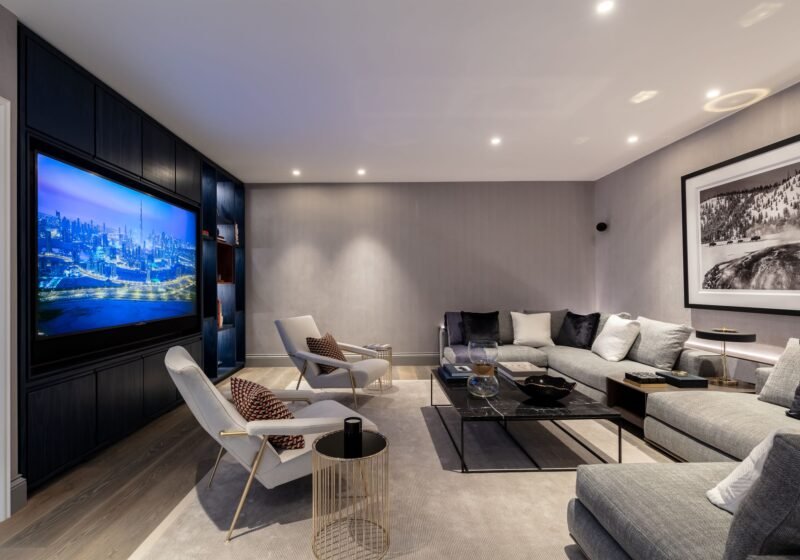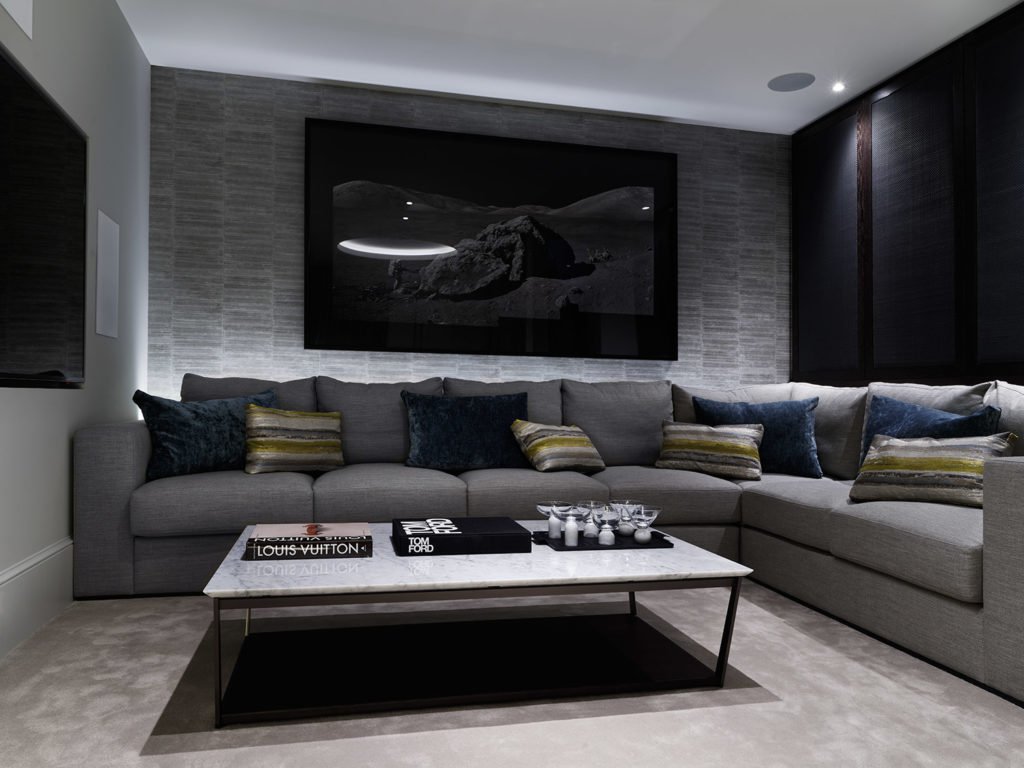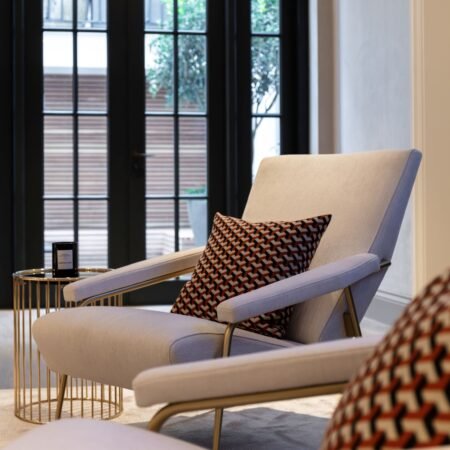How to design a home cinema room
A home cinema or media room is a very popular request from many of our clients. If it’s a big house with multiple rooms, it’s possible to be very creative indeed with glamorous home theatre ideas. But we can also create a Home Cinema in smaller homes, by designing a dual-purpose media room.
We don’t let our clients compromise their living space when they ask what is needed in a media room. Our team is experienced in coming up with media room ideas that can result in a beautifully planned home cinema room that will keep all members of the family, as well as their guests, happy on film nights! So, how do you make a film room in your house? Here are the angles we consider when embarking on a design scheme for our clients…
THE SIZE & SHAPE OF THE ROOM
We have to start with the practicalities of the available space, naturally. We consider whether our client is happy with the shape of the room as it is, or whether it can be changed and made larger (or smaller) within the scope of the project, as we are often working on several rooms at the same time. Some clients will request a small, cosy, home cinema room which will be used by the family, others are looking for a proper cinematic experience, with a huge screen and extensive seating arrangements. Generally, our experts believe that rectangular rooms are most suited to a good home cinema experience, as there is a larger wall area to accommodate the screen, and sound travels well in such rooms. Square-shaped rooms can limit the sound quality and cause harmonic distortions – so we ensure that the size of the room is appropriate to the size of the screen and the required sound levels.
LIGHT & WINDOWS
Our designers will try to avoid proposing ideas for a home cinema in a room that has lots of natural daylight. In a multi-room project, we will design a floor layout that can make the best use of naturally dark rooms, or even redesign an existing layout to embrace a room without windows. Natural light and reflective surfaces will interfere with the viewing experience and the quality of the screening, so our designers carefully consider all the surfaces within the room. For a dual-purpose room that is also a living room or family room, we would consider blackout blinds to create the right ambiance, and we would suggest the walls and ceilings are decorated in dark, matt shades and textures to reduce light reflection.
WALLS & FLOORING
Sound quality is vitally important in a media or home cinema room, even if the room also doubles up as a living room. To ensure the enjoyment of music, films, and games with high-quality sound we will carefully consider all the materials used, to avoid echo and possible distortion. Ideally, the room will be drywall with studs, with luxurious carpet and underlay to increase sound absorption. Tiles and hardwood flooring, although very desirable in many rooms, are not ideal in a home cinema room. Concrete or bare brick walls, such as those in a contemporary extension, for example, are also to be avoided in a cinema room setting. We often include acoustic paneling in some of our projects to ensure the sound quality is as perfect as possible.
THE SOUND SYSTEM
Everyone has their favourites, and we always discuss this thoroughly with our clients, so we know what sound experience they require. We generally like a surround sound system, such as the Dolby Prologic, the new version is 7.1. The system creates an incredible feeling, as if the sound is traveling around the room, and makes a blockbuster movie very immersive! These systems require at least five speakers and a subwoofer – hence the name for the popular 5.1 Prologic system. For the 5.1 system, we would position three speakers and the woofer at the front of the room, and two speakers on the opposite wall, either side of the main seating area. The 7.1 Prologic system adds another two speakers on the rear wall. Speakers are often integrated into the walls, hence the importance of expert advice and guidance from an interior design team. A simpler option, perhaps for a room that has to be more multi-functional and isn’t just a media room, is to use a soundbar system, where the speaker is placed beneath the television and the sound is projected towards the main seating area – the audience!
THE SCREEN
The TV screen is going to be the main focal point of the room, so it’s important to be very particular and thorough when choosing the perfect screen to suit the room. Our experts will take care of the research and make some suggestions. There are lots of clever options such as screens that can turn into a mirror or display a picture of artwork when not in active use as a television screen. Clients, especially those with teenagers in the home, often have ambitious home cinema ideas and are interested in getting the biggest screen possible. However, that’s not always the best option. We will look at the distance between screen and seating to make sure that the screen size suits the viewing distance that will be most comfortable for all members of the family. A television projector is also an option, but in all cases, we will make sure the viewing angle and distance from the screen, as well as the height of the screen, will provide the best viewing experience for all concerned.
DÉCOR & FURNITURE
There are so many options, décor-wise, with a media room! Some clients ask for very high-tech, cinema-style décor, others want to stay true to their decorative taste throughout the rest of their home. Whatever the decision, our team can create a bespoke home cinema design scheme to fulfill the most complex brief. The modern-classic home cinema room will have clear walls and clutter-free décor to emphasise the functional nature of the room, whilst still providing a luxurious experience.
As a general rule, natural light will interfere with the quality of the screen experience, so the ability to block out light is very important. We can design interlined curtains and blackout blinds that will block out every possible chink of light. We find that darker shades for furniture and wallcoverings are preferred by most of our clients. Wall-to-wall carpet, as mentioned earlier, will absorb extraneous sound and add a comfortable and luxurious feel to the room. Some beautifully soft and glamorous cushions and throws also add that touch of luxe, too! The seating must be super-comfortable and depends on the size of the room itself and the number of viewers it will need to accommodate. Modular and sectional upholstery is a popular solution for media room furniture, perhaps with powered reclining units, chaise-longue elements, or simply a few extra upholstered footstools which can be positioned as needed. Sometimes we source cinema-style extra features for home cinema furniture and seating, such as fold-out console tables, cup holders, individual seat lighting, and connections for headphones or charging points.
TECHNICAL ASPECTS
One of the reasons for involving a professional design team to create a cinema/media room is to ensure that the ‘background equipment’ is hidden or disguised, and that wiring and connectivity are integrated. Our design team can provide bespoke entertainment units that can blend into your décor, or become a feature in their own right. Entertainment units, which are often a good choice for a multi-purpose room, can be purpose-designed to accommodate gaming and streaming equipment and extra surround-sound speakers. These units can be full wall height to accommodate the TV, whilst hiding all the connections, too. The lower section of the units is for storage – after all the handsets and headsets need to be tidied away occasionally, and there’s also the joy of an integrated wine and soft drinks fridge, plus a drawer or cupboard for snacks and treats! Our own Joinery team will work hard to ensure that all the audio-visual systems, speaker systems, and all the required cables and connections are precisely planned and are easy to locate within the unit. We can also incorporate panels or a faux wall to alter the proportions of the room to accommodate technical equipment.
For a dual-purpose cinema/media room, there’s the possibility of installing a hidden projector with a drop-down screen for the home cinema descending from the ceiling. That certainly adds the ‘wow factor to a living room or family room, and once again, our Joinery team is able to create the necessary disguises to keep cables and equipment discreet or hidden. Home cinema lighting is as important as the lighting in all the other rooms throughout the home. The quality of lighting is hugely important to the overall atmosphere. There needs to be discreet low-lighting for the cinema when it’s family movie night, as well as lighting that’s suitable for an everyday living room if it’s a dual-purpose room. Our team works with NV Integration and Livewire to provide complete functionality to our clients for these very special projects.





